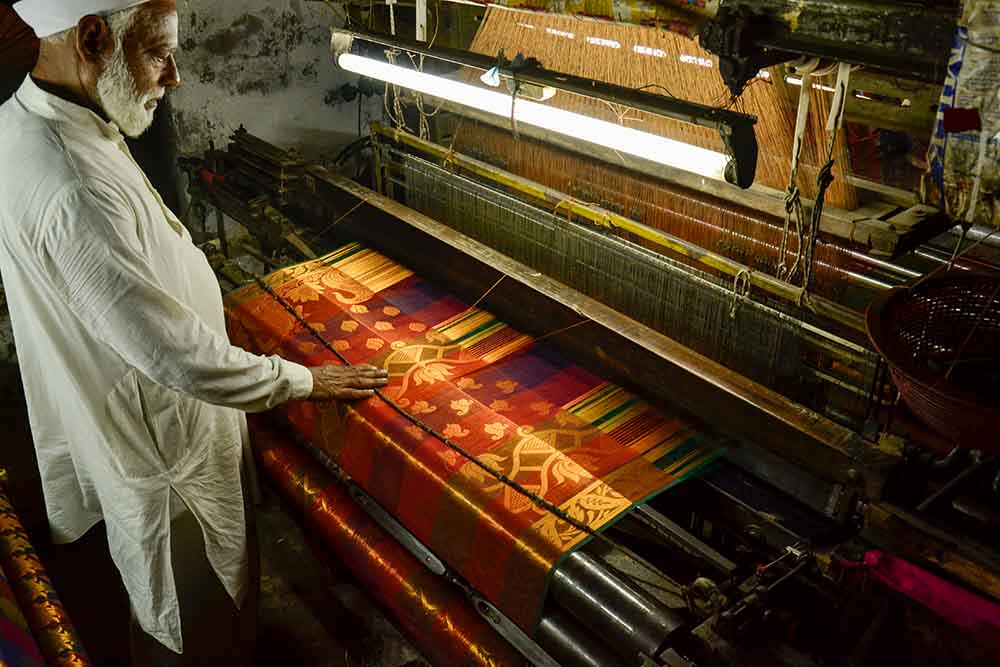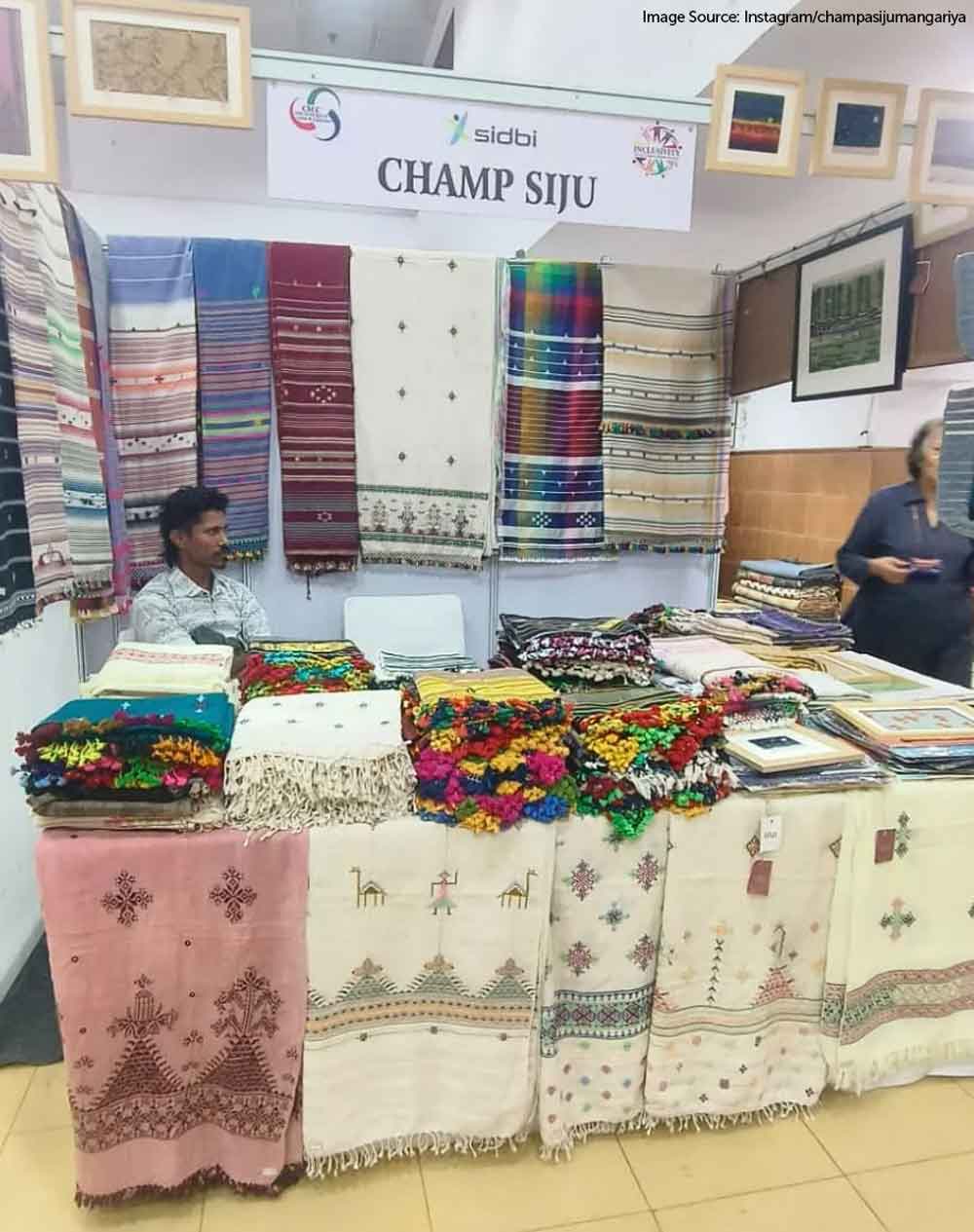The sound of a handloom at work or the rhythmic tapping of a block printer carving intricate designs onto fabric feels almost like a heartbeat—steady, constant, and enduring. But what happens when this heartbeat slows down? Are we witnessing the Indian artisan, the karigar, age out of existence, or are we too busy chasing fast fashion to notice their quiet evolution?
This question lingered in my mind as I spoke with artisan-focused brands, but it truly crystallised during a conversation with Estiyak, a karigar my family has worked with for over a decade. He shared how the younger generation in his community is exploring diverse careers—ones that offer stability and new opportunities. It made me wonder: how many artisans like him are out there, perfecting their craft while pondering if their legacy will continue through the next generation?
The conversation, much like the crafts themselves, is intricately layered. With curiosity as my guide, I set out to explore whether the craft and artisan space holds true promise for future generations of karigars. As a young fashion enthusiast, I’ve always found myself gravitating towards handcrafted treasures more than some of my peers. But it made me wonder—do young artisans and craft entrepreneurs share the same enthusiasm? Is the Indian karigar truly fading into irrelevance, or are we overlooking their resilience and the industry's potential for reinvention? Let’s unravel this narrative, thread by thread, through the voices of artisans and the champions of their craft.

Image used for representational purposes only.
Statistics: Error 404 with a Side of Hope
Before diving into the industry’s pulse on whether the Indian karigar is ageing, I turned to the most logical first step: statistics. While age-specific data on artisans remains elusive, the numbers I did find painted a fascinating picture. Here’s the quick download:
The Indian handicraft industry employs over 7 million people officially—excluding the countless artisans working informally—and churns out an impressive variety of products, from woodware and art metalware to hand-printed textiles and imitation jewellery. Meanwhile, the handloom sector boasts 23.77 lakh looms, providing livelihoods to over 35 lakh people, with a staggering 25 lakh of them being women. Similarly, in the broader handicraft sector, of the estimated 68.86 lakh artisans, 38.61 lakh are women, comfortably outnumbering their male counterparts at 30.25 lakh.

Image used for representational purposes only.
The takeaway? The handicraft industry isn’t just a robust, fast-growing pillar of the economy—it’s a women-powered force redefining traditional crafts with their steady hands and unwavering leadership.
What Women Said
As women emerged as the clear statistical frontrunners in the artisanal space, I found myself in conversation with an enterprising young weaver, Champa Siju. Based in Kutch, a vibrant hub for all things handicraft, Siju crafts everything from intricate woven wall art to stunning handloom cotton saris. One such sari, a collaborative creation with her husband and fellow weaver Chandresh Mangariya, stood out as a testament to her skill and dedication at a recent event I went to.
Siju’s journey into weaving began in 2015 when she decided to trade the rigidity of a factory job for the creative freedom of her family’s craft. Despite initial discouragement from her father, who feared the challenges of the trade, Siju took up weaving as a personal challenge—and mastered it within a week. ‘It’s in our blood,’ she says, as I sense the pride in her voice.

Image Source: Instagram/champasijumangariya
As Champa Siju’s journey in the world of crafts evolved, so did her appreciation for the work she inherited. When I asked her if there were any downsides to being a weaver, her response was swift and certain. ‘My ancestors have been doing this for generations. I grew up watching them weave, so there was no doubt in my mind when I made the decision. I knew it would require hard work, but that’s true for any job. It was never a question for me,’ she explained with quiet confidence.
Marriage, too, was a deliberate choice tied to her craft. For Siju, it was clear—her life partner had to be a fellow weaver, someone who would not only understand but support her work. And as she chuckled while recounting her partnership with Chandresh, it was evident she made the right call.

Image Source: Instagram/champasijumangariya
By the end of our conversation, one thing stood out clearly: for the younger generation to thrive in the crafts, they need two key things—unwavering support from their families and meaningful encouragement from the industry. With those in place, the future of Indian craftsmanship looks far from bleak. But that’s not all—the new generation brings with it a world of possibilities, technology, and challenges. ‘I feel the younger generation is more connected to the outside world. They not only have the advantage of generational knowledge but also a window to the world through technology. They can collaborate and explore opportunities that were scarce just a few decades ago. I see so many success stories of young artisanal entrepreneurs giving a new dimension to their craft,’ says Anavila Misra, a designer known for her deep collaboration and unwavering support of both the craft and the karigars who bring her designs to life.

Designer Anavila Misra | Image Source: Instagram/anavila_m
From the outset, Anavila’s vision extended beyond creating beautiful garments; it was about preserving and honouring the art of handloom weaving. Over the years, she has witnessed first-hand the growth and progress of the weavers she works with—an evolution that, for Misra, is the truest form of success for her label. ‘What makes you optimistic about the artisan communities I work with?’ I asked her. ‘It’s the generation of knowledge, the incredible skill, and a willingness to adapt and explore,’ she says. This optimism is not just about the future of Indian handicrafts; it’s about the bright potential she sees in the hands of the younger generation of artisans.

Image Source: Instagram/anavila_m
Overcoming Barriers
By now, my optimism had turned into firm conviction. While craft clusters may face challenges in sustaining traditional methods, it’s the innovative solutions and leadership guiding them out of these hurdles that truly drive transformation. A shining example of such progress is Looms of Ladakh, a cooperative brand that empowers women artisans in Ladakh by providing them with a stable source of income and ownership. ‘We have seen no decline in interest. In fact, when we started the women artisans were older, but over the last three and half years more younger women have been trained and now work with us. A lot of them are even graduates with a passion for the crafts. This has been possible because they see this activity as a sure source of income in Ladakh along with ownership with cooperative as a business model,’ shares founder Abhilasha Bahuguna. Looms of Ladakh not only revitalises traditional Pashmina weaving but also fosters economic independence and sustains the region's heritage crafts.

Image Source: Instagram/loomsofladakh
This wave of support extends beyond individual initiatives to government schemes like the National Handicrafts Development Programme (NHDP), which combines marketing support, skill development, and welfare programs like the Ambedkar Hastshilp Vikas Yojana (AHVY). With a focus on upgrading infrastructure, technology, and promoting premium and utility-based handicrafts, NHDP paves the way for a more sustainable crafts ecosystem. Similarly, the PM Vishwakarma Scheme, with an allocation of INR 13,000 crore, provides artisans with financial aid, advanced training, stipends, toolkits, and credit support. Marketing support initiatives like branding and eCommerce onboarding ensure their crafts reach wider audiences while maintaining authenticity.
However, policy-driven initiatives are only part of the puzzle. Bahuguna emphasises the importance of brands and entrepreneurs in sustaining the craft economy. ‘Brands and entrepreneurs must first provide financial security to the artisans – both old and new. This will happen through properly researched and designed products, for the correct market and at the correct price. When the business is sustainable and guarantees fair remuneration for all involved, only then will it be lucrative for more people to join this industry,’ she says.

Artisans at work, Looms of Ladakh | Image Source: Instagram/loomsofladakh
Bahuguna’s point about creating the right kind of artisanal products really resonated with me. It brought to mind Tubruk, a brand I’ve been following on Instagram. Founded by Inshada Bashir Mir, Tubruk is dedicated to reviving and supporting Kashmiri crafts like Aari embroidery, Tilla work, Sozni embroidery and handwoven Pashmina, promoting sustainable livelihoods for the artisans they collaborate with. What truly caught my eye were Tubruk’s accessories featuring the iconic Kashmiri Aari and Sozni embroidery. ‘Being from a craft family background, I have always been deeply connected to Kashmiri artistry. My father is a carpet weaver, and my mother practices Sozni embroidery, so crafts have been a part of my life since childhood. This personal connection, combined with the lack of other career opportunities in Kashmir apart from government jobs, inspired me to find a way to preserve and innovate within this traditional art form. By creating unique products like embroidered accessories, I aim to honour my roots while providing artisans with new platforms to showcase their talent and secure sustainable livelihoods,’ says Mir. While Aari and Sozni are traditionally seen on Pashmina shawls and winter wear in the northern regions, Tubruk’s innovative jewellery and bags bring this craft into the spotlight year-round—perfect for craft lovers across the country. ‘There is some reluctance among the younger generation, primarily due to limited financial stability, lack of social recognition, and the perception that crafts are not a sustainable career option. However, not all young people shy away from this field. Some have stepped forward to start businesses in crafts, driven by a passion to preserve their heritage and innovate,’ explains Mir.

Image Source: Instagram/tub.ruk
Scaling up crafts is evidently the key to driving growth in the industry and creating countless artisan success stories, Mir believes. ‘One of the biggest challenges is the need for financial support and connections to reach international markets, as the demand for Kashmiri crafts is high outside India, especially in foreign countries,’ she says. With Tubruk, Mir aims to bridge the gap by empowering artisans, improving livelihoods, and helping them connect with global audiences to expand their reach.

Image Source: Instagram/tub.ruk
Another example of the collective effort to bridge the gap is Reliance's Swadesh initiative. Launched as part of Reliance Retail’s larger mission to celebrate and promote India’s rich cultural heritage, Swadesh focuses on empowering artisans and preserving traditional crafts. The initiative aims to create a sustainable ecosystem by directly connecting artisans with larger markets, ensuring they receive fair value for their work. Through partnerships with karigars across India, Swadesh provides essential support in skill development, infrastructure, and technology. It also works on product innovation, helping artisans adapt traditional techniques to create contemporary, market-friendly designs. This blend of heritage and modernity showcases how scaling crafts can become a transformative tool for artisans and the craft industry alike.

Image Source: Instagram/swadesh_online
So, is the Indian karigar going strong?
Absolutely! After so many conversations brimming with optimism about the craft industry's potential—and backed by the numbers to prove it—I was fully convinced of the bright future awaiting young artisans. I even shared everything I’d learned with Estiyak, from government schemes and supportive initiatives to brands he could connect with, ensuring he had the tools to help others see just how promising the world of crafts can be.
In the hustle and glamour of urban living, especially in a city like Mumbai, it’s easy to overlook how far the craft industry has evolved. It’s no longer just the older generation quietly crafting in the shadows of lesser-known towns. Today, young artisans and entrepreneurs are stepping up, revolutionising the space and turning traditional crafts into thriving, modern businesses.